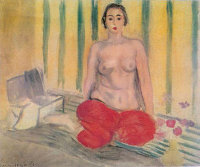 Odalisque is the French form of the Turkish odalık. It refers to a low status female harem slave, a girl kept far from the sultan’s sight. Rather than interact with royalty, an odalisque’s job was to assist his wives and concubines. An extraordinary beauty or a gifted dancer could rise from the level of odalisque and become a concubine. If selected she would train to service the sultan. Only after this type of sexual contact did she rise in status.
Odalisque is the French form of the Turkish odalık. It refers to a low status female harem slave, a girl kept far from the sultan’s sight. Rather than interact with royalty, an odalisque’s job was to assist his wives and concubines. An extraordinary beauty or a gifted dancer could rise from the level of odalisque and become a concubine. If selected she would train to service the sultan. Only after this type of sexual contact did she rise in status.
French artists have long held interest in the notion of odalisques. The neo-classical artist Jean Auguste Dominique Ingres painted many of them. So did François Boucher, Jules Joseph Lefebvre, Eugune Delacroix and Pierre-Auguste Renoir. In the 1920s, Henri Matisse adopted the theme. He painted several of them.
In 1925, Matisse painted Odalisque in Red Pants with oriental flare and vibrant colors. To Susan Burns’ undoubted chagrin, the odalisque is bare chested, clad only in red pants. The painting was originally purchased by a private collector whose estate sold it to New York’s Marlborough Gallery. In 1981, the Caracas Contemporary Art Museum acquired it for $400,000.00.
In 2002, the museum staff recognized the painting as a fake. Since it’s provenance was impeccable, it was clear the original was swapped out for a forgery. Its disappearance set off an international search led by law enforcement agencies throughout the globe. Museum directors were convinced it was an inside job. How do you swap the original with a forgery without inside assistance?
After nearly a decade in hiding, Odalisque in Red Pants has surfaced in Miami. Pedro Antonio Marcuello Guzman, 46, of Miami, FL, and Maria Martha Elisa Ornelas Lazo, 50, of Mexico City, negotiated its sale to under cover agents. The asking price? A mere $740,000.
